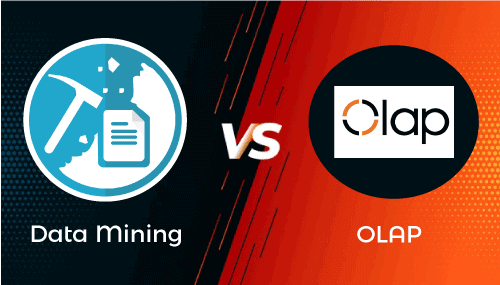Difference between Data Mining and OLAPData mining and OLAP are the two common Business Intelligence technologies. BI is the computer-based methodology for the identification and extraction of significant information from business-related data. Data mining refers to the field of computer science, which deals with the extraction of data, trends and patterns from huge sets of data. On the other hand, OLAP stands for Online Analytical Processing. As the name suggests, OLAP is a technology of immediate access to data with the help of multidimensional structures. Before start, the difference between data mining and OLAP (Online Analytical Processing), let's understand the two terms separately. What is Data Mining?Data mining refers to mining knowledge from a huge amount of data. In other words, you can say that data mining means gathering information and assembling data from various areas like data warehouses and data mining algorithms, searching for trends, patterns that business organizations can use to uplift customer service, thereby increasing their profit. Properties of data miningThese are the key properties of data mining
Architecture of data miningA data mining system may have the given primary components. Knowledge base Knowledge base refers to the knowledge of the domain that is used to evaluate the resulting trends and patterns. Data Mining Engine Data mining engine is the major component of the data mining system and consists of a set of functional modules for various tasks, for example, classification, prediction, outlier analysis, etc. Pattern Evaluation Module The pattern evaluation module is mainly responsible for the pattern investigation using a threshold value. UI (User Interface) With the help of this module, users and the data mining system communicates with each other. Data Mining ProcessFollowing steps involved in the process of data mining:
What is OLAP?OLAP stands for Online Analytical Processing. It is a computing method that allows users to extract useful information and query data in order to analyze it from different angles. For example, OLAP business intelligence queries usually aid in financial reporting, budgeting, predict future sales, trends analysis and other purposes. It enables the user to analyze database information from different database systems simultaneously. OLAP data is stored in multidimensional databases. OLAP and data mining look similar since they operate on data to gain knowledge, but the major difference is how they operate on data. OLAP tools provide multidimensional data analysis and a summary of the data. Key features of OLAP
Applications of OLAP
Difference between data mining and OLAP
Next TopicDescriptive vs Predictive Data Mining
|
 For Videos Join Our Youtube Channel: Join Now
For Videos Join Our Youtube Channel: Join Now
Feedback
- Send your Feedback to [email protected]
Help Others, Please Share









